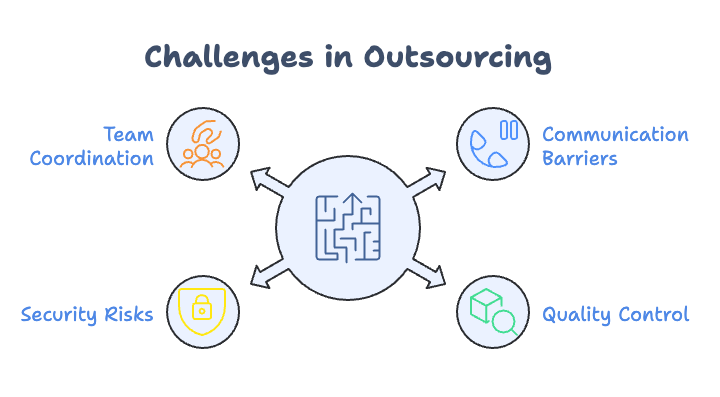“When coding professionals from around the world are only a phone call away, why build everything in-house?” That question is more relevant and important than ever nowadays.
This guide takes you through the changing landscape of programming outsourcing and how it can lead to faster, more intelligent development, whether you’re launching a product, growing your team, or chasing aggressive deadlines.
Programming outsourcing is a strategy that is similar to software outsourcing and involves outsourcing your company’s programming. Programming outsourcing enables you to work on your project for a reasonable price with qualified and well-experienced programmers from all over the world.
Programming outsourcing is an effective strategy used by startups and Fortune 500 companies. In fact, according to Statista, the IT outsourcing market is estimated to reach around $541 billion in 2025.
We’ll go over important trends, highlight the true advantages (and difficulties) of outsourcing coding, and assist you in selecting the most suitable partner based on your objectives, financial constraints, and technological needs.
The fact is that technology and its trends advance quickly. Outsourced programming enables you to maintain flexibility, access worldwide knowledge, and concentrate on the things that move your company forward.
Programming Outsourcing in 2025: What’s Changed?
Trends Driving the Shift
These days, the programming outsourcing market is very different from what it was even five years ago. Here is why:
Artificial Intelligence (AI) is changing development processes: Nowadays, outsourcing code development comes with smarter, faster tools like AI-assistants and automated QA.
Working remotely is a normal thing: Distance is not an obstacle. Projects involving outsourced programming typically involve international collaboration.
The gig industry is getting bigger: Do you need a blockchain specialist for two months? Simple. It’s easier than ever to put together short-term, high-impact teams.
Why It’s Relevant
In 2025, programming outsourcing will be about flexibility, accessibility, creativity, and innovation rather than cost savings. Companies that outsource computer programming are becoming more agile and intelligent as AI and remote collaboration transform the tech stack.
When to Outsource: What to Keep and What to Send
Not every task is supposed to be outsourced, and that’s okay. Here’s a brief breakdown.
What to Outsource
- Non-essential duties: Consider feature additions, bug fixes, and front-end enhancements—perfect for programming that is outsourced.
- Specialized knowledge: Computer programming can be outsourced to blockchain, AI/ML, or embedded systems.
- Temporary surges: A major release is coming? Scale down after ramping up with outsourcing.
What to Stay In-House
- Core intellectual property: Your tech strategy, algorithms, business model, and trade secrets? Keep them private and internal.
- Vision-driven innovation: Projects that require tight feedback loops with execs or product leads.
Decision Framework
“Does this require our unique vision—or just skilled execution?” ask yourself.
Outsourcing coding is frequently the better course of action if it’s the latter.
Top Benefits of Outsourcing Programming in 2025

1. Hire Top Talent
Do you need a Kotlin developer with more than five years of fintech experience? Or an engineer in computer vision? I wish you luck in closing these positions fast.
Programming outsourcing allows you to quickly access experts from around the world without having to deal with the hassle of hiring new staff and dealing with a lot of interviews.
2. Cost Efficiency
Yes, in 2025, cost will still be important. Strong talent is available at competitive prices without sacrificing quality when outsourcing to areas like Eastern Europe or Latin America.
To help you with selecting the most appropriate model, this article compares nearshore and offshore models.
3. The Ability to Scale
One of the key advantages of outsourced programming: scale up when you need speed, scale down when you don’t. No ongoing overhead, and hiring doesn’t take too long.
4. Pay Attention to Your Main Objectives
Your internal team can concentrate on product strategy, expansion, and innovation by delegating time-consuming tasks. That is the true return on investment of outsourcing code development.
5. Market Speed
Outsourced programming teams produce work more quickly without compromising quality by utilizing DevOps, CI/CD, and agile methodologies.
Navigating the Challenges of Outsourcing
Yes, there are struggles, but they’re manageable with the correct and well-planned game plan.

Barriers to Communication
Time zones can make things more difficult. The solution? Even across continents, communication is easy with async tools like Slack, Notion, and Loom.
Control of Quality
Concerned about the quality? Don’t be. Just make sure you:
- Write precise specifications
- Perform reviews every week
- Use CI pipelines & version control
Risks to Security
Outsourcing entails data sharing, so be cautious. Select suppliers who offer:
- IP protection and NDAs
- ISO accreditations
- Protocols for encrypted storage and transfer
Team Coordination
Being on the same page is key to success when working with remote developers. Sprint goals, weekly calls, and common KPIs all aid in closing the gap.
Choosing the Right Outsourcing Partner
Don’t just pick the first agency on Google. Spend some time assessing possible partners according to their track record, communication style, industry experience, and area of expertise. The ideal outsourcing partner will comprehend your technical requirements, share your business objectives, and be dedicated to long-term cooperation rather than just short-term delivery.
Here’s how to choose smart:
Key Criteria
- Technical background and expertise: Can they show past wins for your tech needs?
- Communication skills: Ask how they handle async workflows.
- Security check: Are they ISO-certified? Do they sign NDAs?
Questions to Ask
- “How do you manage time zone differences?”
- “What’s your QA and review process?”
- “How do you onboard new clients?”
Red Flags
- Vague answers on process or security
- No case studies or tech expertise transparency
- Poor English or late responses in early emails
Real-World Wins: Outsourcing Success Stories
LITSLINK’s experience in outsourced programming covers multiple industries. Our ability to work across different niches enables us to comprehend particular business requirements and provide customized software solutions that produce tangible outcomes.
We provide the expertise and adaptability to assist clients in a variety of industries, whether it be through the development of scalable platforms, the integration of state-of-the-art technologies, or the acceleration of product development.
Here are just a few examples:
- Case Study 1: Social Network
By providing a high-performing mobile application with unique backend integration, we assisted a startup in growing to over 100,000 users in just six months. They were successful in acquiring and retaining users because of our solution’s ability to handle data efficiently and synchronize in real time, as well as guarantee seamless performance even when user loads increased.
- Case Study 2: Platform for Real Estate
We created a scalable property listing and management system with user-specific search filters and cutting-edge geolocation capabilities. This solution reduced our client’s platform’s time to market by 40% by streamlining backend operations and expediting the property discovery process. They were able to stay ahead of the competition, launch more quickly, and draw in more users early on thanks to it.
- Case Study 3: Video Platform | Athletics Merch
We built a seamless, user-friendly platform that enabled athletes to stream exclusive video content and sell branded merchandise directly to their fanbase. The platform greatly enhanced user interaction and created new revenue streams by fusing captivating multimedia experiences with integrated eCommerce features. This led to higher conversion rates, brand loyalty, and engagement.
Conclusion: Your Path to Smarter Development
Outsourcing programming may transform a company’s capacity to access global talent, save costs, and accelerate time to market. You can handle outsourcing confidently if you understand the concept, benefits, and best practices.
Let’s recap:
- Programming outsourcing in 2025 is faster, more flexible, and more powerful than ever.
- Use it to access niche skills, reduce costs, and scale smartly.
- Focus your in-house team on vision and innovation.
- Choose a partner with proven experience, strong communication, and airtight security.
What’s Next?
Thinking about giving outsourcing a shot?
- Start small. Test with a short project.
- Evaluate results. Look for productivity, speed, and collaboration.
- Go big. Grow with confidence once you achieve decent results and good KPIs.
LITSLINK is here to help—whether you need a full team, a specialist, or a long-term partner to accelerate your roadmap.





